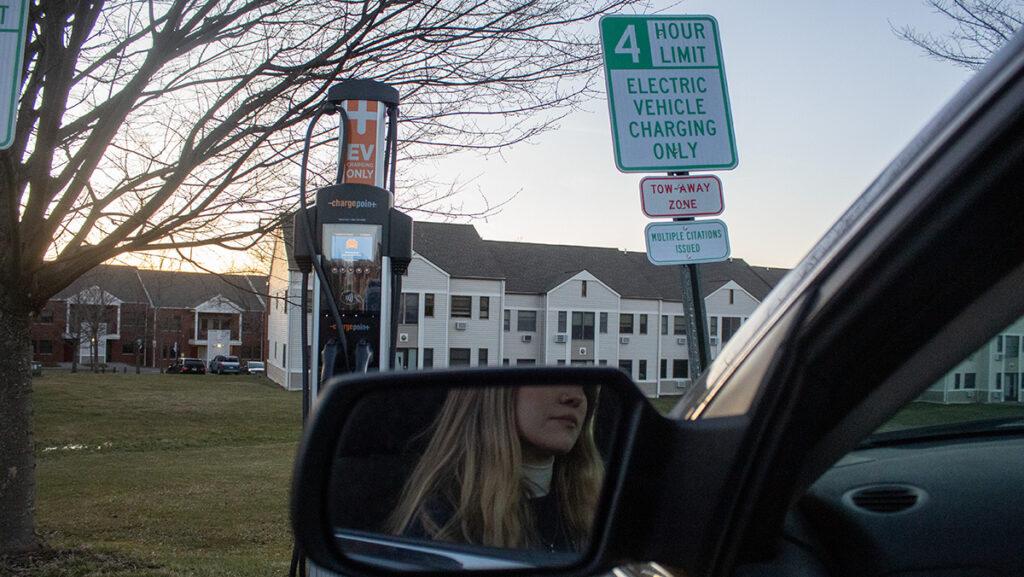As electric vehicles are becoming more popular, Ithaca College is looking to expand the limited number of electric vehicle chargers it has on campus in order to keep up with demand and maintain its sustainability goals.
Marc Anthonisen, lecturer in the Department of Environmental Studies and Sciences, moved to Ithaca from Hong Kong when he became a Cornell University graduate student in 2019 and saw on Cornell’s website that he would not need a car to get around Ithaca. He figured he could use public transportation instead. However, he quickly found public transportation to be unreliable.
Since moving, Anthonisen said he bought an electric Hyundai Kona. Anthonisen said that he notices more EVs on the road throughout Ithaca and that more chargers around town are necessary.
“Given we have a wave of EV purchases, a place like Ithaca really does need a publicly accessible fast charger,” Anthonisen said. “Otherwise what do you do?”
Anthonisen said direct current fast chargers, also known as level three chargers, send electricity directly to the car’s battery, allowing the electric vehicle to charge faster. The second standard charger for EVs are level two chargers. He said these chargers take about 7–9 hours to charge an EV battery to 80%, while level three DC fast chargers take about 30–50 minutes to charge to that point. Anthonisen said it is safest to charge an EV to 80% so as not to degrade the battery.
The college only has level two chargers, in the Visitor Lot and at the Circle Apartments Community Center parking lot. Anthonisen said that having just two chargers makes charging harder since more students and faculty are driving EVs. He said that getting more level two and DC fast chargers onto the college’s campus would also help get more prospective students interested in the college.
“The college won’t make money off of having EVs, but it would be a great showcase for a family who is visiting Ithaca College, no matter if they have an EV or they don’t,” Anthonisen said. “They would see a long row of EV chargers, it would send a signal saying, ‘Ithaca College really is serious about their sustainability efforts.’”
Junior Michael Crater, a car enthusiast, said he originally became interested in cars when he was younger and is now a car journalist. He said he does not think an expansion of chargers on campus will help student drivers because EVs are not as accessible for college students. According to The New York Times, the average cost for an EV in the U.S. is $61,488 and the usual demographic for EVs is high-income households.
“The Environmental Protection Agency [EPA] is definitely trying to promote more electric vehicles, but until they become more widespread and affordable, it’s not really going to matter for college students,” Crater said.
According to The Ithacan, the station at the Circle Apartments was installed in December 2017. The station was paid for by a grant from the New York State Energy Research and Development Authority.
According to the U.S. Department of Energy, many colleges and universities are able to pay for electric vehicle charging stations through awards for research and public and private donations to the school. The New York State Energy Research & Development Authority provides some New York colleges and universities with funding for their charging stations. These colleges include Clarkson University, SUNY New Paltz, Purchase College SUNY and Suffolk County Community College.
Scott Doyle, director of Energy Management and Sustainability at the college, said the costs for the chargers depend on many factors, including what level the charger is, if the charger will be mounted on a pedestal or on the side of a building, preparations for the electric work, preparations for the designated site for the charger and ongoing costs of making the charger’s software accessible for drivers. He said a dual-port charger, the current type of charge the college has, which allows for two drivers to charge at once, ranges between $4,000–$8,000.
“There’s no fee to use the chargers on campus,” Doyle said. “There is a cost to the college in terms of electricity, but also the installation of the chargers. The most expensive piece is … preparing the electric system to receive a charger. The work of the electrician is the most expensive part.”
Doyle said that in February, there were 124 charging sessions, 45 unique users and an average charging time of three hours and 50 minutes. He also said the college dispensed 2-megawatt hours of electricity, costing the college $200, a good price for the college.
“We’ve found a lot of different users who use the chargers on a monthly basis and they’re pretty actively used,” Doyle said. “It’s common to go by [the Visitor Lot] and see the charger in use. That tells me, along with conversations with staff and faculty across campus and discussions in the classroom, that there’s an interest in expanding charger use.”
Doyle said the college wants to add more EV charging stations on campus and is investigating possible areas for expansion.
“Areas that present the greatest potential for expansion are those areas with easier access to electric service, including A&E and areas where parking lot improvements are planned in the near future, like the Terraces,” Doyle said.
Doyle said EV users will need a permit for the parking lots where chargers are. He said they will also need an account through ChargePoint, an app that helps drivers find charging stations.
“As we expand this in college lots, students will need to carry a permit,” Doyle said. “I did a case study in the University of Vermont and students need access to the specific lot the charger is in.”
ChargePoint is an EV charging network that works to design, install and finance charging stations and all the technology that is used in order to connect charging stations to the electric grid. Crater said that EV ChargePoint chargers are usually located on major highways.
“The company just sets up charging stations around the country,” Crater said. “Most of those are not necessarily only in rural and small towns, there are quite a few still in urban areas, but they’re predominantly along interstates.”
Susan Witherup, professor in the Department of Biology, said she has not used the chargers on campus in the past year because she has had negative experiences with them in the past.
“The one that I look for is the one in the Visitor Lot,” Witherup said. “A couple of times I’ve gone there and at least one [of the two charging cords] is not working. … That was pretty disappointing to me because I don’t think it was necessarily Ithaca College’s fault. When I contacted the Office of Energy Management at the time, they had already heard about it not being functional, and they had put in requests and ChargePoint was just slow to respond to the requests.”
Doyle said that although EV chargers are expensive, the college qualifies for a NYSEG grant that would help fund expansion. The college is eligible because it pays a systems benefit charge in its NYSEG bill.
According to Doyle, an SBC is a state-mandated charge for all electricity and natural gas customers and is used to fund clean energy activities. The SBC helps the college save money because it takes advantage of clean energy rebates from NYSERDA.
Doyle said his team has been working with NYSEG and school districts and towns across New York state to replace gas vehicles with EVs in the college’s fleet. Doyle said the only EV the college has in the fleet is the Eco-Reps vehicle. He said he has been looking at maintenance costs and charging requirements. He said the college is looking into a large fleet charging station in the facilities and maintenance area of the college’s campus.
“We are also looking to expand our public charging and getting it up and running in a more reliable way,” Doyle said. “I’ve had some trouble with the charger in the Community Center and in the visitors’ parking lot.”
Doyle said the charger at Circles Community Center went down recently and he and his team are looking into what caused the issue. He said they suspect either the charger’s signal went down, it needs a new SIM card or it needs a new plug.
Doyle said one disadvantage of having chargers on campus is their potential unreliability. He said another disadvantage would be toward drivers without electric vehicles.
“There’s an important equity piece to this too,” Doyle said. “We want to encourage the use of chargers, but we recognize that electric vehicles — even with subsidies — are a more expensive vehicle, so does that mean we displace another potential driver in parking as well as bike parking? These are all important things to take into account.”
Paula Turkon, assistant professor in the Department of Environmental Studies and Science, said that although the chargers promote energy-efficient cars and the use of renewable energy, people must keep in mind where and how the electricity for the chargers is being made and if it is being made sustainably.
“You have to evaluate the renewable energy we use, because [Ithaca College is] buying it, but it’s being produced somewhere else,” Turkon said. “Even the solar that we produce is being produced somewhere else.”
Turkon said decisions made about sustainable energy are never cut and dry. She said there are still other factors to consider, like how much renewable energy the college buys from NYSEG’s electric grid in order to offset the amounts of renewables it cannot produce.
“[The energy the college produces] goes into the grid, we work off the grid, so we don’t actually use that energy directly,” Turkon said. “It’s just that we’re helping to facilitate the generation of that energy for the grid. So to me, any of these kinds of decisions are not nearly as obvious as the media often makes it seem.”










